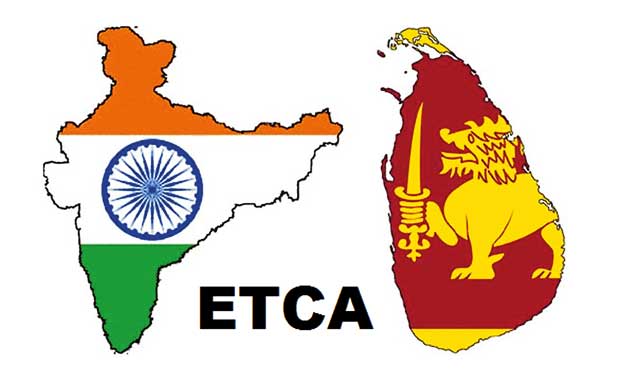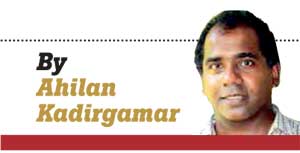Reply To:
Name - Reply Comment
Last Updated : 2024-04-20 11:24:00

I have been arguing for some time that the Indian media and academia have a skewed understanding of Sri Lanka. The debacle of Indian intervention in Sri Lanka in the 1980s and the recent geopolitics of India and China’s competing strategic interests in the region, have contributed to most Indian analysis of Sri Lanka, limiting to issues of security. Indeed, there is a dearth of in-depth Indian study and commentary on the political economy of Sri Lanka.
This was not always the case, Jawaharlal Nehru University scholars such as Urmila Phadnis for example, sought to understand religion and politics in Sri Lanka, and put forward a critical analysis of Indo-Lanka relations in the 1970s and 1980s. However, in recent times, Indian discourse seems to be only concerned about Colombo’s proximity to itself, vis-à-vis to China and the West. Alternatively, the predicament in the war-torn North has provided room for opportunistic political campaigns in Tamil Nadu and sensationalised writings on war-time suffering. A comprehensive perspective of the social, economic and political challenges facing the war-torn population rarely figures in such commentary.
example, sought to understand religion and politics in Sri Lanka, and put forward a critical analysis of Indo-Lanka relations in the 1970s and 1980s. However, in recent times, Indian discourse seems to be only concerned about Colombo’s proximity to itself, vis-à-vis to China and the West. Alternatively, the predicament in the war-torn North has provided room for opportunistic political campaigns in Tamil Nadu and sensationalised writings on war-time suffering. A comprehensive perspective of the social, economic and political challenges facing the war-torn population rarely figures in such commentary.
While I have been critical of such Indian discourse, I am also aware that on this side of the Palk Strait, we hardly analyse the political economy of India. Rarely do we discuss the political conflicts and the political changes, be it the conflicts in Kashmir, Chhattisgarh or the North-East, or for that matter the apparent rise of ‘Hindutva’, an ideology of Hindu supremacy, in India. We are even less aware of the tremendous economic changes in India over the last three decades.
In this piece, I want to introduce two important research papers published in recent months on the political economy of India. The first paper is: ‘Riskless Capitalism’ in India: Bank Credit and Economic Activity by Azad, Bose and Dasgupta published in the Economic and Political Weekly, 5 August 2017, which analyses the contemporary crisis prone dynamics in the Indian economy. The second paper is: Indian Income Inequality, 1922-2014: From British Raj to Billionaire Raj? by Chancel and Piketty published as Wealth and Income Database Working Paper, July 2017, which addresses the tremendous rise in inequality following liberalisation in India.
Both the papers draw upon evidence from extensive research. The first looks into the dynamics of the contemporary Indian economy and hidden characteristics behind its high growth, and the other based on historical data on incomes and wealth spanning close to a century. Such research nevertheless has been condensed into simple but powerful arguments about flawed state policies. The analysis in these papers not only helps those seeking economic changes in India, but also provides crucial lessons for policy makers around the world. The findings are also relevant to people’s movements that are trying to build economic democracy in different countries.
The concept “riskless capitalism” was in fact coined by the former Governor of the Reserve Bank of India (India’s Central Bank) Raguram Rajan in 2014, and it referred to how the public sector banks (PSBs) had to take much of the risk, getting none of the returns in good times and absorbing much of losses in bad times. The Indian state encouraged this model, where private banks and the corporate sector enjoyed “riskless capitalism” at the cost of the public.
 Azad et al took that argument further in looking at the Indian economy since liberalisation beginning in the mid-1980s and accelerating after 1991. Their critique of the recent economic boom in India is significant:
Azad et al took that argument further in looking at the Indian economy since liberalisation beginning in the mid-1980s and accelerating after 1991. Their critique of the recent economic boom in India is significant:
“Our findings suggest that while trade and financial opening up may have triggered faster growth almost a decade after the initiation of reforms, a crucial role was played by the state in sustaining the first boom of the 2000s and prolonging the boom beyond the 2007-08 global economic crisis. A credit bubble was generated through the PSBs, complemented by external debt finance, particularly in the infrastructure sector. The bubble eventually burst in 2011-12, resulting in a severe loan crisis engulfing the banking system.”
The state of affairs is not very different in Sri Lanka. In fact, the Rajapaksa regime also propelled such an economic boom, including by encouraging state-owned banks such as the Bank of Ceylon and the National Savings Bank to float massive dollar-denominated corporate bonds above US$ 500 million each. They have to be paid back with extremely high interest rates in 2018, and are likely to be a huge strain on the banking sector. The current government with its thrust for an international financial centre has not necessarily shifted from such a strategy. Rather, they are projecting, with great confidence, Public Private Partnerships (PPPs) as the remedy for all that ails our economy.
According to Azad et al, a strategy of promoting PPPs for infrastructure development was taken forward in the 2000s in India as well. But in reality, much of the credit and the risk that entails such PPPs was borne by the PSBs. In fact, according to one review, 68% of PPP projects were financed by debt, of which 82% of the financing came from PSBs. Thus, a larger share of the PPP projects were ultimately financed by the state. The researchers end their paper with the question: “why is the state choosing to provide subsidies to corporates rather than itself undertaking those investments?”
Chancel and Piketty, with their recent paper on inequality in India, building on Piketty’s magnum opus Capital in the 21st Century, have sparked another powerful debate in recent weeks. Their research has illustrated the ups and downs in inequality in India, based on income tax data published from 1922. Given that many of the public debates in India have been on macroeconomic impacts and poverty, this paper brought the question of inequality into sharp focus.
Their findings are very worrying. While income inequality decreased during the late colonial period  coinciding with the Great Depression and World War, and further decreased during the decades after Indian Independence, in recent decades with liberalisation, income inequality has greatly increased and now at the highest level.
coinciding with the Great Depression and World War, and further decreased during the decades after Indian Independence, in recent decades with liberalisation, income inequality has greatly increased and now at the highest level.
Even the share of national income that the middle classes, particularly the middle 40% of the population, and certainly the bottom 50% of the population, has decreased drastically after liberalisation.
Drawing from their paper then, inequality in India just before liberalisation in 1982-83 and the most recent data in 2013-14 illustrates the following. The top 0.01% of population’s share of national income has gone from 0.4% to 3.8%, for the top 0.1% of population from 1.7% to 8.6%, and top 1% of population from 6.2% to 21.7%. On the other hand, the middle 40% of population’s national income share went from 46% to 29.6% and the bottom 50% share went from 23.6% to 14.9%. Clearly, the recent period - that some characterise as “shining India” - has only led to the concentration of national wealth within the elite.
There is a powerful neo-liberal discourse in Sri Lanka calling for greater integration of our economy with that of India and China, the two major powers in the region. I have in previous columns discussed the implications of trade liberalisation with such powers; both for our economy and our workers, whose bargaining power will decrease. The pertinent question here is whether connecting our small economy to such giant economies might lead to a similar dynamic here, of bubble-induced crises and sharpening inequalities.
At a minimum, the recent evidence from India should prompt us to pursue a different economic trajectory–to one that is not centred on financialisation and liberalisation, but one that ensures greater redistribution of wealth through progressive taxation and a role for the state in meaningful infrastructure and production.
That would be the only way forward if we want to avoid the impact of a crises that transfers the burden on the public, thereby drastically widening the inequalities in our society. It is also high time for us to start paying attention to inequality in Sri Lanka, particularly the economic dynamics leading to rising inequalities since the open economic reforms of 1977. That may also give the state and its policy makers a clue about why there is mass discontent, growing instances of protests and trade union struggles in Sri Lanka.

Add comment
Comments will be edited (grammar, spelling and slang) and authorized at the discretion of Daily Mirror online. The website also has the right not to publish selected comments.
Reply To:
Name - Reply Comment
On March 26, a couple arriving from Thailand was arrested with 88 live animal
According to villagers from Naula-Moragolla out of 105 families 80 can afford
Is the situation in Sri Lanka so grim that locals harbour hope that they coul
A recent post on social media revealed that three purple-faced langurs near t